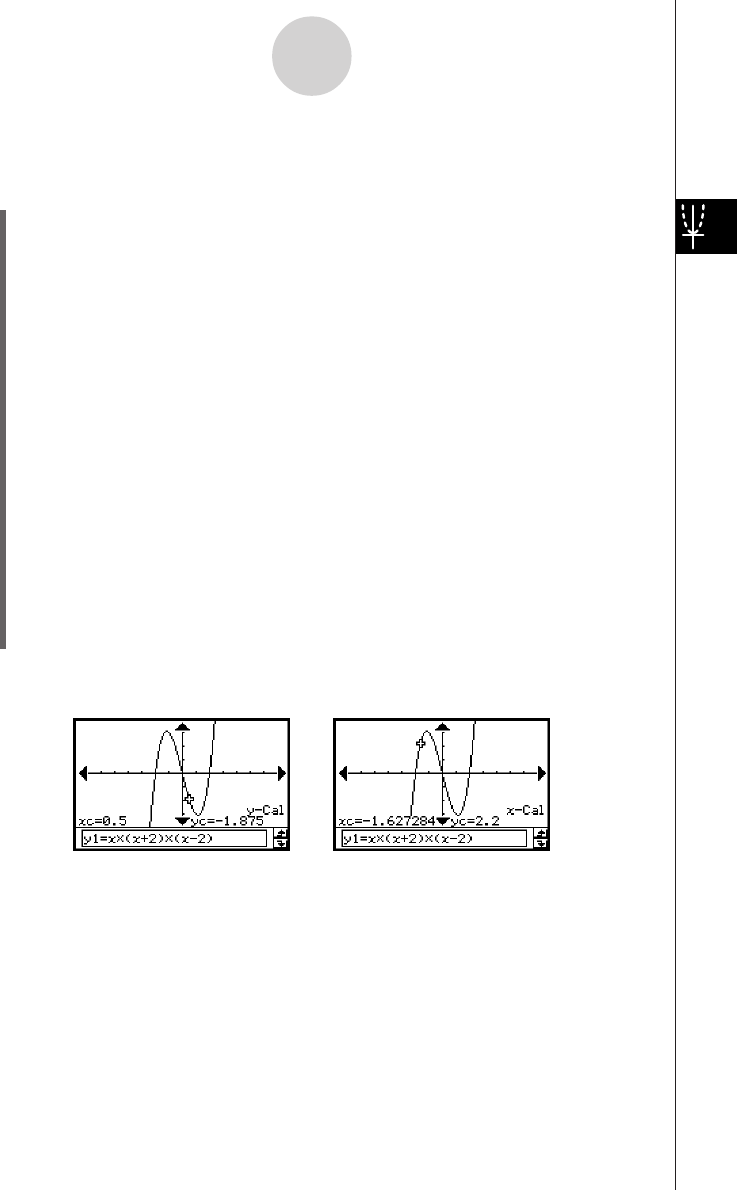User Manual
Table Of Contents
- Getting Ready
- Contents
- About This User’s Guide
- Chapter 1 Getting Acquainted
- Chapter 2 Using the Main Application
- 2-1 Main Application Overview
- 2-2 Basic Calculations
- 2-3 Using the Calculation History
- 2-4 Function Calculations
- 2-5 List Calculations
- 2-6 Matrix and Vector Calculations
- 2-7 Using the Action Menu
- 2-8 Using the Interactive Menu
- 2-9 Using the Main Application in Combination with Other Applications
- 2-10 Using Verify
- Chapter 3 Using the Graph & Table Application
- Chapter 4 Using the Conics Application
- Chapter 5 Using the 3D Graph Application
- Chapter 6 Using the Sequence Application
- Chapter 7 Using the Statistics Application
- 7-1 Statistics Application Overview
- 7-2 Using List Editor
- 7-3 Before Trying to Draw a Statistical Graph
- 7-4 Graphing Single-Variable Statistical Data
- 7-5 Graphing Paired-Variable Statistical Data
- 7-6 Using the Statistical Graph Window Toolbar
- 7-7 Performing Statistical Calculations
- 7-8 Test, Confidence Interval, and Distribution Calculations
- 7-9 Tests
- 7-10 Confidence Intervals
- 7-11 Distribution
- 7-12 Statistical System Variables
- Chapter 8 Using the Geometry Application
- Chapter 9 Using the Numeric Solver Application
- Chapter 10 Using the eActivity Application
- Chapter 11 Using the Presentation Application
- Chapter 12 Using the Program Application
- Chapter 13 Using the Spreadsheet Application
- Chapter 14 Using the Setup Menu
- Chapter 15 Configuring System Settings
- 15-1 System Setting Overview
- 15-2 Managing Memory Usage
- 15-3 Using the Reset Dialog Box
- 15-4 Initializing Your ClassPad
- 15-5 Adjusting Display Contrast
- 15-6 Configuring Power Properties
- 15-7 Specifying the Display Language
- 15-8 Specifying the Font Set
- 15-9 Specifying the Alphabetic Keyboard Arrangement
- 15-10 Optimizing “Flash ROM”
- 15-11 Specifying the Ending Screen Image
- 15-12 Adjusting Touch Panel Alignment
- 15-13 Viewing Version Information
- Chapter 16 Performing Data Communication
- Appendix

20050501
u To determine coordinates at a particular point on a graph
Example: To graph the function y = x (x + 2)(x – 2) and determine the y-coordinate when
x = 0.5, and the x-coordinate when y = 2.2
(1) Display the View Window dialog box, and then configure it with the following
parameters.
xmin = –7.7, xmax = 7.7, xscale = 1
ymin = –3.8, ymax = 3.8, yscale = 1
(2) On the Graph Editor window, input and store y = x (x + 2)(x – 2) into line y1, and then
tap $ to graph it.
•Make sure that only y1 is checked.
(3) To obtain the value of y for a particular x-value, tap [Analysis], [G-Solve], and then
[y-Cal].
• This displays a dialog box for specifying the x-value.
(4) For this example, input 0.5 and then tap [OK].
• This moves the pointer to the location on the graph where x = 0.5, and displays the
x-coordinate and y-coordinate at that location.
(5) To obtain the value of x for a particular y-value, tap [Analysis], [G-Solve], and then
[x-Cal].
• This displays a dialog box for specifying the y-value.
(6) For this example, input 2.2 and then tap [OK].
• This moves the pointer to the location on the graph where y = 2.2, and displays the
x-coordinate and y-coordinate at that location.
Result Screenshots
3-8-5
Analyzing a Function Used to Draw a Graph
Tip
• When there are multiple results for the above procedure, press e to calculate the next value.
Pressing d returns to the previous value.










